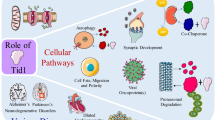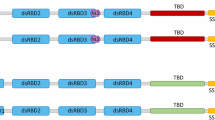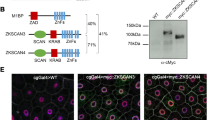Abstract
Introduction: DNAJA3, also known as Tid1 (Tumorous imaginal disc 1), is a mammalian mitochondrial DNAJ/HSP40 co-chaperone protein. DNAJA3 is predominantly localized in mitochondrial matrix which enables them to interact with mitochondrial HSP70 or other client proteins. This chapter summarizes the physiological and biochemical functions of DNAJA3 in tumorigenesis, development and mitochondrial homeostasis, and its underlying molecular mechanisms.
Methods: All literatures were systematically searched through EndNote and web search engines. The reported discoveries and our findings were specifically categorized into multiple roles of DNAJA3.
Results: DNAJA3 has been identified as tumor suppressor. Overexpression of DNAJA3 not only inhibits cancer cells proliferation but also induces cells death. In opposite, downregulation of DNAJA3 enhances malignant properties such as cell migration and invasion in vitro, and tumor growth in vivo. Acting as a tumor suppressor, DNAJA3 can interfere with the matrix metalloproteinase to repress the cancer metastasis. Additionally, DNAJA3 is involved in early embryogenesis, thymocyte development, muscular development and mitochondrial biogenesis in normal physiological condition. Mechanistically, DNAJA3 interacts with DNAK/HSP70 to prevent aggregation of mitochondrial complex I and to contribute mtDNA maintenance.
Conclusions: Most of DNAJA3 client proteins are related to cancer. Therefore, it is of the importance of DNAJA3 to orchestrate its function in tumorigenesis. DNAJA3 also important in development and mitochondrial homeostasis.
Access this chapter
Tax calculation will be finalised at checkout
Purchases are for personal use only
Similar content being viewed by others

Abbreviations
- APC:
-
Adenomatous polyposis coli
- CRC:
-
Colorectal cancer
- Cyt:
-
Cytoplasmic
- DCM:
-
Dilated cardiomyopathy
- EBV:
-
Epstein-Barr virus
- EGFR:
-
Epidermal growth factor receptor
- EOPD:
-
Early onset Parkinson’s
- ER:
-
Endoplasmic reticulum
- HBV:
-
Hepatitis B virus
- HCC:
-
Hepatocellular carcinoma
- hERG:
-
Human ether-a-go-go-related gene
- HGF:
-
Hepatocyte growth factor
- HNSCC:
-
Head and neck squamous cell carcinoma
- HSP:
-
Heat shock protein
- HSV:
-
Herpes simplex virus type 1
- HTLV-1:
-
Human T cell leukemia virus type 1
- MEF:
-
Mouse embryonic fibroblast
- Mem:
-
Membrane
- MetR:
-
c-Met receptor tyrosine kinase
- Mito:
-
Mitochondria
- NSCLC:
-
Non-small cell lung carcinoma
- Opa1:
-
Optic atrophy 1
- RCC-CICs:
-
Renal cell carcinoma cancer- initiating cells
- Tid1:
-
Tumorous imaginal disc 1
- TNFα:
-
Tumor necrosis factor-alpha
- VHL:
-
Von Hippel-Lindau protein
- YY1:
-
Yin Yang 1
References
Ahrendt E, Braun JE (2010) Channel triage: emerging insights into the processing and quality control of hERG potassium channels by DnaJA proteins 1, 2 and 4. Channels 4:335–336
Bae MK, Jeong JW, Kim SH et al (2005) Tid-1 interacts with the von Hippel-Lindau protein and modulates angiogenesis by destabilization of HIF-1alpha. Cancer Res 65:2520–2525
Bascos NAD, Mayer MP, Bukau B, Landry SJ (2017) The Hsp40 J-domain modulates Hsp70 conformation and ATPase activity with a semi-elliptical spring. Protein Sci 26:1838–1851
Berger BJ, Müller TS, Buschmann IR et al (2003) High levels of the molecular chaperone Mdg1/ERdj4 reflect the activation state of endothelial cells. Exp Cell Res 290:82–92
Castro JP, Wardelmann K, Grune T, Kleinridders A (2018) Mitochondrial chaperones in the brain: safeguarding brain health and metabolism? Front Endocrinol 9:196
Cheetham ME, Caplan AJ (1998) Structure, function and evolution of DnaJ: conservation and adaptation of chaperone function. Cell Stress Chaperones 3:28
Chen CY, Chiou SH, Huang CY et al (2009) Tid1 functions as a tumour suppressor in head and neck squamous cell carcinoma. J Pathol 219:347–355
Chen YS, Chang CW, Tsay YG et al (2018) HSP40 co-chaperone protein Tid1 suppresses metastasis of head and neck cancer by inhibiting Galectin-7-TCF3-MMP9 axis signaling. Theranostics 8:3841–3855
Cheng H, Cenciarelli C, Shao Z et al (2001) Human T cell leukemia virus type 1 tax associates with a molecular chaperone complex containing hTid-1 and Hsp70. Curr Biol 11:1771–1775
Cheng H, Cenciarelli C, Nelkin G et al (2005) Molecular mechanism of hTid-1, the human homolog of Drosophila tumor suppressor l (2) Tid, in the regulation of NF-κB activity and suppression of tumor growth. Mol Cell Biol 25:44–59
Cheng LH, Hung KF, Lee TC et al (2016) Mitochondrial co-chaperone protein Tid1 is required for energy homeostasis during skeletal myogenesis. Stem Cell Res Ther 7:185
Copeland E, Balgobin S, Lee C, Rozakis-Adcock M (2011) hTID-1 defines a novel regulator of c-met receptor signaling in renal cell carcinomas. Oncogene 30:2252
Cui X, Choi H-K, Choi Y-S et al (2015) DNAJB1 destabilizes PDCD5 to suppress p53-mediated apoptosis. Cancer Lett 357:307–315
Dhennin-Duthille I, Nyga R, Yahiaoui S et al (2011) The tumor suppressor hTid1 inhibits STAT5b activity via functional interaction. J Biol Chem 286:5034–5042
Edo De Bock C, Lin Z, Mekkawy AH, Byrne JA, Wang Y (2010) Interaction between urokinase receptor and heat shock protein MRJ enhances cell adhesion. Int J Oncol 36:1155–1163
Edvardson S, Cinnamon Y, Ta-Shma A et al (2012) A deleterious mutation in DNAJC6 encoding the neuronal-specific clathrin-uncoating co-chaperone auxilin, is associated with juvenile parkinsonism. PLoS One 7:e36458
Edwards KM, Munger K (2004) Depletion of physiological levels of the human TID1 protein renders cancer cell lines resistant to apoptosis mediated by multiple exogenous stimuli. Oncogene 23:8419–8431
Eisenberg E, Greene LE (2007) Multiple roles of auxilin and hsc70 in clathrin-mediated endocytosis. Traffic 8:640–646
Elsayed L, Drouet V, Usenko T et al (2016) A novel nonsense mutation inDNAJC6Expands the phenotype of autosomal-recessive juvenile-onset Parkinson’s disease. Ann Neurol 79:335–337
Eom CY, Lehman IR (2002) The human DnaJ protein, hTid-1, enhances binding of a multimer of the herpes simplex virus type 1 UL9 protein to oris, an origin of viral DNA replication. Proc Natl Acad Sci U S A 99:1894–1898
Fan C-Y, Lee S, Cyr DM (2003) Mechanisms for regulation of Hsp70 function by Hsp40. Cell Stress Chaperones 8:309
Fan C-Y, Lee S, Ren H-Y, Cyr DM (2004) Exchangeable chaperone modules contribute to specification of type I and type II Hsp40 cellular function. Mol Biol Cell 15:761–773
Goswami AV, Chittoor B, D’Silva P (2010) Understanding the functional interplay between mammalian mitochondrial Hsp70 chaperone machine components. J Biol Chem 285:19472–19482
Gotoh T, Terada K, Mori M (2001) hsp70-DnaJ chaperone pairs prevent nitric oxide-mediated apoptosis in RAW 264.7 macrophages. Cell Death Differ 8:357
Gotoh T, Terada K, Oyadomari S, Mori M (2004) hsp70-DnaJ chaperone pair prevents nitric oxide-and CHOP-induced apoptosis by inhibiting translocation of Bax to mitochondria. Cell Death Differ 11:390
Hafizur RM, Yano M, Gotoh T, Mori M, Terada K (2004) Modulation of chaperone activities of Hsp70 and Hsp70-2 by a mammalian DnaJ/Hsp40 homolog, DjA4. J Biochem 135:193–200
Hang H, He L, Fox MH (1995) Cell cycle variation of Hsp70 levels in HeLa cells at 37 C and after a heat shock. J Cell Physiol 165:367–375
Hatle KM, Gummadidala P, Navasa N et al (2013) MCJ/DnaJC15, an endogenous mitochondrial repressor of the respiratory chain that controls metabolic alterations. Mol Cell Biol 33:2302–2314
Hayashi M, Imanaka-Yoshida K, Yoshida T et al (2006) A crucial role of mitochondrial Hsp40 in preventing dilated cardiomyopathy. Nat Med 12:128
Jan CI, Yu CC, Hung MC et al (2011) Tid1, CHIP and ErbB2 interactions and their prognostic implications for breast cancer patients. J Pathol 225:424–437
Kampinga HH, Craig EA (2010) The HSP70 chaperone machinery: J proteins as drivers of functional specificity. Nat Rev Mol Cell Biol 11:579
Kampinga HH, Hageman J, Vos MJ et al (2009) Guidelines for the nomenclature of the human heat shock proteins. Cell Stress Chaperones 14:105–111
Kang K, Guo K, Tang Q et al (2012) Interactive cellular proteins related to classical swine fever virus non-structure protein 2 by yeast two-hybrid analysis. Mol Biol Rep 39:10515–10524
Kim S-W, Chao T-H, Xiang R et al (2004) Tid1, the human homologue of a Drosophila tumor suppressor, reduces the malignant activity of ErbB-2 in carcinoma cells. Cancer Res 64:7732–7739
Kim S-W, Hayashi M, Lo J-F et al (2005) Tid1 negatively regulates the migratory potential of cancer cells by inhibiting the production of interleukin-8. Cancer Res 65:8784–8791
Köroğlu Ç, Baysal L, Cetinkaya M, Karasoy H, Tolun A (2013) DNAJC6 is responsible for juvenile parkinsonism with phenotypic variability. Parkinsonism Relat Disord 19:320–324
Kurisu J, Honma A, Miyajima H, Kondo S, Okumura M, Imaizumi K (2003) MDG1/ERdj4, an ER-resident DnaJ family member, suppresses cell death induced by ER stress. Genes Cells 8:189–202
Kurzik-Dumke U, Czaja J (2007) Htid-1, the human homolog of the Drosophila melanogaster l(2)tid tumor suppressor, defines a novel physiological role of APC. Cell Signal 19:1973–1985
Lee B, Ahn Y, Kang SM et al (2015a) Stoichiometric expression of mtHsp40 and mtHsp70 modulates mitochondrial morphology and cristae structure via Opa1L cleavage. Mol Biol Cell 26:2156–2167
Lee H, Kim J, Kim K, Heo J, Kwak S, Han J (2015b) Genotoxic stress/p53-induced DNAJB9 inhibits the pro-apoptotic function of p53. Cell Death Differ 22:86
Lin S-Y, Hsueh C-M, Yu S-L et al (2010) HLJ1 is a novel caspase-3 substrate and its expression enhances UV-induced apoptosis in non-small cell lung carcinoma. Nucleic Acids Res 38:6148–6158
Liu T, Jiang W, Han D, Yu L (2012) DNAJC25 is downregulated in hepatocellular carcinoma and is a novel tumor suppressor gene. Oncol Lett 4:1274–1280
Lo JF, Hayashi M, Woo-Kim S et al (2004) Tid1, a cochaperone of the heat shock 70 protein and the mammalian counterpart of the Drosophila tumor suppressor l(2)tid, is critical for early embryonic development and cell survival. Mol Cell Biol 24:2226–2236
Lo JF, Zhou H, Fearns C, Reisfeld RA, Yang Y, Lee JD (2005) Tid1 is required for T cell transition from double-negative 3 to double-positive stages. J Immunol 174:6105–6112
Lu B, Garrido N, Spelbrink JN, Suzuki CK (2006) Tid1 isoforms are mitochondrial DnaJ-like chaperones with unique carboxyl termini that determine cytosolic fate. J Biol Chem 281:13150–13158
Mayer M, Bukau B (2005) Hsp70 chaperones: cellular functions and molecular mechanism. Cell Mol Life Sci 62:670
Meshalkina DA, Shevtsov MA, Dobrodumov AV et al (2016) Knock-down of Hdj2/DNAJA1 co-chaperone results in an unexpected burst of tumorigenicity of C6 glioblastoma cells. Oncotarget 7:22050
Milarski KL, Morimoto RI (1986) Expression of human HSP70 during the synthetic phase of the cell cycle. Proc Natl Acad Sci 83:9517–9521
Mitra A, Fillmore RA, Metge BJ et al (2008) Large isoform of MRJ (DNAJB6) reduces malignant activity of breast cancer. Breast Cancer Res 10:R22
Mitra A, Menezes ME, Shevde LA, Samant RS (2010) DNAJB6 induces degradation of β-catenin and causes partial reversal of mesenchymal phenotype. J Biol Chem 285:24686–24694
Ng AC-H, Baird SD, Screaton RA (2014) Essential role of TID1 in maintaining mitochondrial membrane potential homogeneity and mitochondrial DNA integrity. Mol Cell Biol 34:1427–1437
Nishizawa S, Hirohashi Y, Torigoe T et al (2012) HSP DNAJB8 controls tumor-initiating ability in renal cancer stem–like cells. Cancer Res 72:2844–2854
Olgiati S, Quadri M, Fang M et al (2016) D NAJC 6 mutations associated with early-Onset P Arkinson’s disease. Ann Neurol 79:244–256
Park B-C, Yim Y-I, Zhao X, Olszewski MB, Eisenberg E, Greene LE (2015) The clathrin-binding and J-domains of GAK support the uncoating and chaperoning of clathrin by Hsc70 in the brain. J Cell Sci 128:3811–3821
Patra M, Weiss C, Abu-Libdeh B et al (2019) A novel variant of the human mitochondrial DnaJ protein, Tid1, associates with a human disease exhibiting developmental delay and polyneuropathy. Eur J Hum Genet 27:1072–1080
Pröls F, Mayer MP, Renner O et al (2001) Upregulation of the cochaperone Mdg1 in endothelial cells is induced by stress and during in vitro angiogenesis. Exp Cell Res 269:42–53
Qian J, Perchiniak EM, Sun K, Groden J (2010) The mitochondrial protein hTID-1 partners with the caspase-cleaved adenomatous polyposis cell tumor suppressor to facilitate apoptosis. Gastroenterology 138:1418–1428
Qiu X-B, Shao Y-M, Miao S, Wang L (2006) The diversity of the DnaJ/Hsp40 family, the crucial partners for Hsp70 chaperones. Cell Mol Life Sci CMLS 63:2560–2570
Robichon C, Varret M, Le Liepvre X et al (2006) DnaJA4 is a SREBP-regulated chaperone involved in the cholesterol biosynthesis pathway. Biochim Biophys Acta (BBA)-Mol Cell Biol Lipids 1761:1107–1113
Sarkar S, Pollack BP, Lin KT et al (2001) hTid-1, a human DnaJ protein, modulates the interferon signaling pathway. J Biol Chem 276:49034–49042
Schilling B, De-Medina T, Syken J, Vidal M, Münger K (1998) A novel human DnaJ protein, hTid-1, a homolog of the Drosophila tumor suppressor protein Tid56, can interact with the human papillomavirus type 16 E7 oncoprotein. Virology 247:74–85
Shen Y, Meunier L, Hendershot LM (2002) Identification and characterization of a novel endoplasmic reticulum (ER) DnaJ homologue, which stimulates ATPase activity of BiP in vitro and is induced by ER stress. J Biol Chem 277:15947–15956
Shridhar V, Bible KC, Staub J et al (2001) Loss of expression of a new member of the DNAJ protein family confers resistance to chemotherapeutic agents used in the treatment of ovarian cancer. Cancer Res 61:4258–4265
Sinha D, D’silva P (2014) Chaperoning mitochondrial permeability transition: regulation of transition pore complex by a J-protein, DnaJC15. Cell Death Dis 5:e1101
Sohn SY, Kim SB, Kim J, Ahn BY (2006) Negative regulation of hepatitis B virus replication by cellular Hsp40/DnaJ proteins through destabilization of viral core and X proteins. J Gen Virol 87:1883–1891
Strathdee G, Davies B, Vass J, Siddiqui N, Brown R (2004) Cell type-specific methylation of an intronic CpG island controls expression of the MCJ gene. Carcinogenesis 25:693–701
Syken J, De-Medina T, Münger K (1999) TID1, a human homolog of the Drosophila tumor suppressor l (2) TID, encodes two mitochondrial modulators of apoptosis with opposing functions. Proc Natl Acad Sci 96:8499–8504
Traicoff JL, Chung J-Y, Braunschweig T et al (2007) Expression of EIF3-p48/INT6, TID1 and patched in cancer, a profiling of multiple tumor types and correlation of expression. J Biomed Sci 14:395
Trinh DL, Elwi AN, Kim SW (2010) Direct interaction between p53 and Tid1 proteins affects p53 mitochondrial localization and apoptosis. Oncotarget 1:396–404
Truman AW, Kristjansdottir K, Wolfgeher D et al (2012) CDK-dependent Hsp70 phosphorylation controls G1 cyclin abundance and cell-cycle progression. Cell 151:1308–1318
Tsai M-F, Wang C-C, Chang G-C et al (2006) A new tumor suppressor DnaJ-like heat shock protein, HLJ1, and survival of patients with non–small-cell lung carcinoma. J Natl Cancer Inst 98:825–838
Wang C-C, Tsai M-F, Hong T-M et al (2005) The transcriptional factor YY1 upregulates the novel invasion suppressor HLJ1 expression and inhibits cancer cell invasion. Oncogene 24:4081
Wang L, Tam JP, Liu DX (2006) Biochemical and functional characterization of Epstein-Barr virus-encoded BARF1 protein: interaction with human hTid1 protein facilitates its maturation and secretion. Oncogene 25:4320–4331
Wang TH, Lin YH, Yang SC, Chang PC, Wang TC, Chen CY (2017) Tid1-S regulates the mitochondrial localization of EGFR in non-small cell lung carcinoma. Oncogenesis 6:e361
Yang S, Ren X, Liang Y et al (2019) KNK437 restricts the growth and metastasis of colorectal cancer via targeting DNAJA1/CDC45 axis. Oncogene:1–13
Yin X, Rozakis-Adcock M (2001) Genomic organization and expression of the human tumorous imaginal disc (TID1) gene. Gene 278:201–210
Yu VZ, Wong VC-L, Dai W et al (2015) Nuclear localization of DNAJB6 is associated with survival of patients with esophageal cancer and reduces AKT signaling and proliferation of cancer cells. Gastroenterology 149:1825–1836. e1825
Acknowledgements
This study was supported by grants from National Yang-Ming University (108CRC-T402) and the Ministry of Science and Technology, Taiwan (MOST 107-2314-B-010-024-MY3).
Disclosure of Interests
All authors declare they have no conflict of interest.
Ethical Approval for Studies Involving Humans
This article does not contain any studies with human participants performed by any of the authors.
Ethical Approval for Studies Involving Animals
This article does not contain any studies with animals performed by any of the authors.
Author information
Authors and Affiliations
Corresponding author
Editor information
Editors and Affiliations
Rights and permissions
Copyright information
© 2020 Springer Nature Switzerland AG
About this chapter
Cite this chapter
Teo, WH., Fann, YN., Lo, JF. (2020). DNAJA3, a Co-chaperone in Development and Tumorigenesis. In: Asea, A.A.A., Kaur, P. (eds) Heat Shock Proteins in Inflammatory Diseases. Heat Shock Proteins, vol 22. Springer, Cham. https://doi.org/10.1007/7515_2020_33
Download citation
DOI: https://doi.org/10.1007/7515_2020_33
Published:
Publisher Name: Springer, Cham
Print ISBN: 978-3-030-85167-5
Online ISBN: 978-3-030-85168-2
eBook Packages: Biomedical and Life SciencesBiomedical and Life Sciences (R0)



